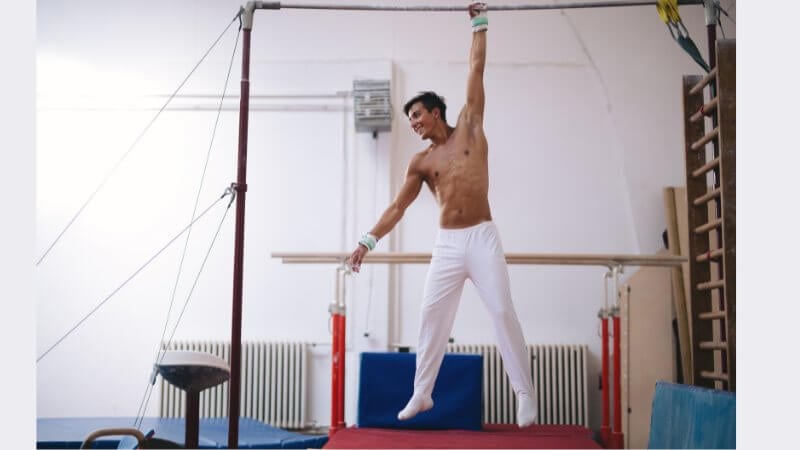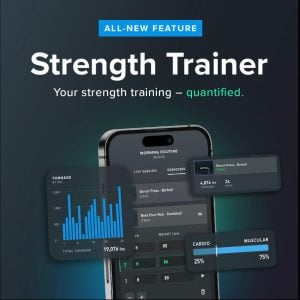It's hard to believe that such a simple exercise can have so many positive effects on our bodies. It's a relatively low-impact movement that can be performed regardless of age or fitness level. It can improve posture and relieve lower back pain as well as strengthen grip and boost your pull-up game.
If you are a competitive type, then you can complete our grip strength workout in the form of a ▶️ 28-day calisthenics dead hang challenge. Who can hold it for the longest? 🙂
So what do you gain by doing regular dead hangs?
Improves grip strength
If you have to release the bar sooner than your back fatigues when doing pull-ups, or if you’re unable to open your grandma’s pickle jar, chances are that you suffer from weak grip strength.
A stronger grip will also benefit other hanging exercises such as pull-ups, chin-ups and leg raises as you will be able to hold on to the bar for longer.
Besides being useful in everyday life, grip strength is also an important biomarker. It is a proxy for overall strength and a predictor of longevity, especially for the elderly.
Alleviates lower back pain
As the dead hang can help to decompress your spine it will alleviate pressure on your spinal discs.
This can be beneficial for people that spend a lot of time sitting as well as those who put a lot of pressure on their spine by lifting heavy weights or running.
Helps with shoulder impingement
Dead hangs are also proven to aid the healing process after suffering from shoulder impingement or rotator cuff injuries. We already explored shoulder injuries in detail, so we won’t dive into it here.
It’s enough to say that the main cause of pain in the shoulder is that the rotator cuff tendons are being irritated by the bone and as a result they get inflamed. By regularly doing a dead hang you alleviate the pressure from your shoulder joints which gives more room to the tendons and ligaments.
If you are interested in this topic Dr. Kirsch (an orthopedic surgeon from Wisconsin) dedicated an entire book to the subject.
Corrects posture
Hanging not only strengthens the muscles in the neck, back, and shoulder area but with consistent practice it can also improve posture. During a dead hang the shoulder blades retract which has a corrective effect on rounded shoulders.
Improves shoulder mobility
Dead hang is very useful in improving overhead shoulder mobility. By stretching the connecting tissue in the shoulders it increases its range of motion.

What is a dead hang and how to do it correctly?
Dead hang or “passive hang” is an isometric calisthenics exercise where you simply just hang from a horizontal bar, relax your shoulder blades and keep your body vertical and feet off the ground.
For optimal execution, I recommend avoiding bending the knees. Find a high enough platform to hang from that will allow you to stretch your entire body. You can use a tree branch, gymnastics rings, pull up bar or the back of a staircase - whatever works for you.
You can use a box or something to step on to reach the bars.
I recommend starting with a pronated grip (overhand grip) as that transfers best to pull ups. To make the exercise more interesting you can:
- use a supinated grip (the one that you use for chin ups)
- if you have access to parallel bars try a neutral grip
- occasionally try an alternating one arm dead hang (once you can hold for 60 seconds with both hands)
- rotate between active and passive hang
To prevent your body from swinging, hold tension in your core and glutes and keep your feet close together.
How long should you dead hang?
If you are trying this for the first time, I recommend starting with shorter sets and higher frequency to accumulate at least 30 seconds daily. For example 6 sets of 5 seconds.
As you get stronger gradually increase the time per set to up to 1 minute so that you are able to accumulate up to 5 minutes of dead hangs on a given day.
What muscles does dead hang work?
Dead hang primarily stimulates the forearm and back muscles.
Interestingly, the muscles located on the hand have no direct impact on grip strength. On the other hand (no pun intended), the gripping and wrist flexion is primarily driven by the flexor digitorum and flexor pollicis longus while the extensor digitorum communis is responsible for the wrist extension and relaxation - these muscles essentially make up the system that we call forearm muscles.
Since the back muscles are mostly relaxed during the dead hang they are engaged to a lesser degree. Even so, the primary back muscles that play a role in a dead hang are the latissimus dorsi (upper back muscle) and the trapezius (which connects your neck with the shoulders).
When should you avoid the dead hang?
If you have any pre-condition or you feel pain when attempting a dead hang, please talk to your doctor first and ask if you are allowed to do this exercise.
This especially applies to people who
- suffered traumatic injuries in their back or shoulder as a result of a fall or accident
- have unstable shoulders that are prone to dislocation
- are old and have not exercised regularly
It's fitting to say: A few minutes of dead hangs a day, keeps the doctor away 🙂




